  tanding
at
the
top
of
the
steps
leading
down
from
the
city
walls near
the
Watertower,
we
can
see
an
interesting
microcosm
of
British
transport
history.
The Shropshire
Union
Canal passes
under
a
railway
bridge
and
then
makes
a
right-angled
turn
to
the
north,
broadening
into
the Tower
Wharf
Basin. tanding
at
the
top
of
the
steps
leading
down
from
the
city
walls near
the
Watertower,
we
can
see
an
interesting
microcosm
of
British
transport
history.
The Shropshire
Union
Canal passes
under
a
railway
bridge
and
then
makes
a
right-angled
turn
to
the
north,
broadening
into
the Tower
Wharf
Basin.
Right: The canal frozen solid during the long hard winter of 1992. Telford's Warehouse is in the background. (Photograph by the author).
To
the
west,
a
branch
leads
down
through
three
locks
to
the River
Dee.
The
railway,
as
previously
mentioned,
passes
through
the
walls
en
route
from
Holyhead
to
London.
Above
the
canal
locks
you
can
see
the
great
concrete
supports
carrying
the
1960s
Inner
Ring
Road
from St. Martin's
Gate-
which
we
shall
visit
shortly-
to
the Fountains
Roundabout.
Just
across
the
road,
and
taking
its
name
from
the
medieval Watertower, Tower
Wharf is
particularly
interesting
corner
of
Chester
that
is
well
worth
interrupting
your
tour
of
the
city
walls
to
explore,
especially
so
as,
in
the
very
near
future,
it
is
due
to
be
radically
redeveloped
by British
Waterways.
 Reportedly
involving
the
construction
of
yet
more
hotels,
apartments
and
offices,
locals
fear
the
changes
may
also
bring
about
the
sweeping
away
or
'prettification'
of
much
that
makes
the
area
special. Reportedly
involving
the
construction
of
yet
more
hotels,
apartments
and
offices,
locals
fear
the
changes
may
also
bring
about
the
sweeping
away
or
'prettification'
of
much
that
makes
the
area
special.
Certainly,
nobody
was
sorry
to
see
the
demolition
of
the
ugly
and
derelict
British
Telecom
office
block
which
formerly
occupied
much
of
the
site,
but
many
feel
it
would
be
a
great
shame
if
other
open
spaces
were
filled
with
mediocre
new
buildings
and
the
existing
businesses
and
boat
residents-
on
and
off
the
water-
driven
out
by
gentrification
and
the
rent
rises
that
inevitably
accompany
it.
(Note the complete- and worrying- lack of water craft but thick press of
new
buildings in the 'artist's impression' of a redeveloped Tower Wharf at the bottom of the page.)
 Telford's
Warehouse-
a
splendid
18th
century
former
canal
warehouse
(seen
in
the
centre
background
of
this
photograph and the one
above)
situated
here
is
a
case
in
point.
For
many
years,
it
has
been
a
unique
popular
live
music
and
arts
venue,
contributing
enormously
to
the
cultural
life
of
the
city-
and
in
the
daytime
and
early
evening
is
a
relaxing
spot,
ideal
for
indulging
in
a
spot
of
well-earned
refreshment
and
good
conversation. Telford's
Warehouse-
a
splendid
18th
century
former
canal
warehouse
(seen
in
the
centre
background
of
this
photograph and the one
above)
situated
here
is
a
case
in
point.
For
many
years,
it
has
been
a
unique
popular
live
music
and
arts
venue,
contributing
enormously
to
the
cultural
life
of
the
city-
and
in
the
daytime
and
early
evening
is
a
relaxing
spot,
ideal
for
indulging
in
a
spot
of
well-earned
refreshment
and
good
conversation.
At
one
point, British
Waterways planned
to
convert
the
building
next
to
it
into
a
hotel
and
hinted
at
turning
Telford's
into
their
idea
of
a
'businessman's
bar'
connected
to
it
by
a
walkway.
Public
opinion-
even
from
within
the
city
council-
considered
many
of
BW's
ideas
for
this
sensitive
site
to
be
'ill
judged'. Chester's Member of Parliament- and local resident- Christine Russell admirably expressed the view that BW's plans "should aspire to the standard of Telford's
rather than dragging Telford's down to the level of BW's plans". The
short-sighted scheme
was
soon
dropped and we're
happy
to
report
that
the
future
of
Telford's
as
we
know
and
love
it
is, for the moment,
now
assured.
Except
that,
on
Saturday,
22nd
July
2000,
Telford's
was
badly
damaged
by
fire! A
small
blaze
broke
out
in
the
kitchen
and
spread
via
ventilation
ducts
to
the
upper
floors
and
roof,
where
the
worst
damage
occured.
All
customers
and
staff
were
safely
evacuated
from
the
building
with
the
exception
of poor Elbow,
the
resident
cat,
who
sadly
died. Telford's
was
consequently
forced
to
remain
closed
for
the
best
part
of
a
year
to
allow
restoration
work
to
take
place
but
eventually
held
its
re-opening
party
on
20th
June
2001-
and
what
a
night
it
was!...
Welcome
back.
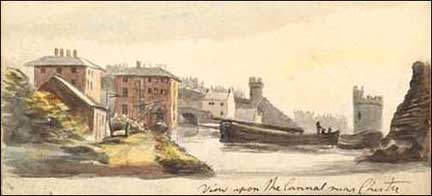
Be
sure
to
visit
the
Telford's website where
you
can
find
full
details
of
their
excellent
programme
of
live
music
events.
Highly
recommended.
This anonymous watercolour shows the Tower Wharf area as it appeared in 1790; somewhat more rural but, on the whole, entirely familiar to modern eyes, Bonewaldesthorne's and the Watertower and Telford's Warehouse looking much as they do to us today.
Close
by
Telford's
Warehouse
is Taylor's
Boatyard (illustrated below),
a
busy
repair
and
restoration
facility,
now
run
by David
Jones
Boat
Builders-
benefitting
the
many
craft
using
this
section
of
the
canal
network,
which
at
its
height
employed
almost
200
people
building
and
maintaining
the
canal
company's
fleet
of
640
wooden
boats. British
Waterways
had
proposed
turning
this
interesting
structure
into office
accomodation,
of
all
things,
but
a
public
outcry
led
to
this
idea
being
abandoned,
and
an
organisation
of
concerned
individuals,
the Taylor's
Yard
Development
Group has
now
appeared,
who
have
held
'open
weekends'
when
they
showed
visitors
around
the
site
and
told
them
something
of
its
history.
The
building
adjoining
Telford's
Warehouse
was
formerly
the Ellsmere
Canal
Tavern (seen in both the old pictures
above)
which
supplied
refreshment
and
accomodation
to
the
many
people
who
travelled
by
canal
boat
from
Tower
Wharf
to
the
Mersey
at Ellsmere
Port and
thence
by
ferry
to Liverpool.
The
service
started
in
1795,
cost
1/6d
1st
class
and
1/-
second
and
took
five
or
six
hours
to
get
to
Liverpool,
refreshments
being
served
on
board.
The
service
was
once
very
popular-
in
1801,
15,000
people
used
it-
but
it
was
forced
out
of
business
by
the
opening
of
the
railway
to
Birkenhead
and
closed
in
1841.
The
building,
until
recently
occupied
as
offices
by
the
Church
of
England,
has
now
been
restored
to
serve
as
British
Waterways'
own
regional
headquarters.
As
part
of
the
redevelopment
of
the
area,
the
old North
Basin,
which
was
filled
in
when
the
canal
network
went
into
decline
during
the
1950s,
was
re-excavated
to
provided
additional
mooring
and
also
to
serve
as
a
'visual
feature'
for
whatever
new
buildings
are
eventually
erected
around
it.
The
project
cost £410,000
and
water
was
first
admitted
to
the
restored
basin
in
July
2000.
A
couple
of
months
later,
in
September,
it
was
formerly
opened
by
Chester's
Lord
Mayor
and
Admiral
of
the
Dee,
Councillor
Reggie
Jones,
who
led
a
fleet
of
historic
boats
into
the
basin
for
the
first
time
in
half
a
century.
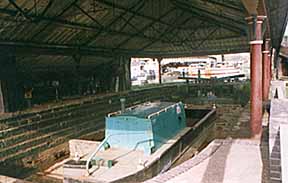 To
assist
the
filling-in
process,
at
least
ten
great
old
wooden
canal
boats
had
been
deliberately
sunk
in
the
basin
and
then
covered
over
with
rubble.
An
archaeological
investigation
funded
by
British
Waterways
in
the
Winter
of
1998
rediscovered
these
old
craft
and
they
could
be
viewed
from
the
bridge
crossing
the
canal
at
this
point.
The
majority
of
them
dated
from
the
1870s
and
would
probably
have
been
operated
by
the Shropshire
Union
Canal
Company at
a
time
when
Tower
Wharf
was
one
of
the
prime
staging
posts
on
the
canal
and
had
a
key
role
in
the
early
transport
network
of
the
North
West. To
assist
the
filling-in
process,
at
least
ten
great
old
wooden
canal
boats
had
been
deliberately
sunk
in
the
basin
and
then
covered
over
with
rubble.
An
archaeological
investigation
funded
by
British
Waterways
in
the
Winter
of
1998
rediscovered
these
old
craft
and
they
could
be
viewed
from
the
bridge
crossing
the
canal
at
this
point.
The
majority
of
them
dated
from
the
1870s
and
would
probably
have
been
operated
by
the Shropshire
Union
Canal
Company at
a
time
when
Tower
Wharf
was
one
of
the
prime
staging
posts
on
the
canal
and
had
a
key
role
in
the
early
transport
network
of
the
North
West.
Efforts
have
been
made
to
ensure
the
preservation
of
at
least
some
of
the
craft,
seven
of
which
are
wide Mersey
Flats and
three
other
traditional
narrow
boats.
This
photograph
shows
one
of
the
hulks
emerging from the mud.
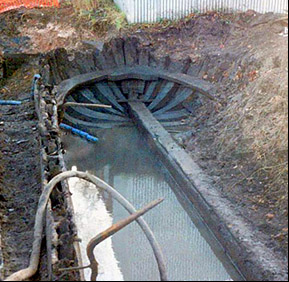 But
not
for
long,
it
seemed,
for
in June
2001,
British
Waterways
unveiled
their
long-awaited £35 million
"blueprint
for
the
future"
of
the
8.5
acre
brownfield
site.
Working
in
conjunction
with
developers
CTP
Ltd
and
Bellway
Homes,
plans
include
the
construction
of
a
200-bed
hotel,
located
directly
opposite
Telford's Warehouse
(marked
with
a
red
dot
in
the
illustration
below)
and
run
by
"an
international
operator"
(the
1997
planning
permission
was
for
just
80
beds)
and
141
residential
units,
including
a
mixture
of
townhouses,
maisonettes
and
flats-
the
centrepiece
of
which
will
be
a
seven-storey
tower
block
offering
views
over
the
canal
and
designed
to
act
as
a
'focus'
for
the
development.
The
majority
of
the
surrounding
structures
will
be
of
three
and
four
storeys
however. But
not
for
long,
it
seemed,
for
in June
2001,
British
Waterways
unveiled
their
long-awaited £35 million
"blueprint
for
the
future"
of
the
8.5
acre
brownfield
site.
Working
in
conjunction
with
developers
CTP
Ltd
and
Bellway
Homes,
plans
include
the
construction
of
a
200-bed
hotel,
located
directly
opposite
Telford's Warehouse
(marked
with
a
red
dot
in
the
illustration
below)
and
run
by
"an
international
operator"
(the
1997
planning
permission
was
for
just
80
beds)
and
141
residential
units,
including
a
mixture
of
townhouses,
maisonettes
and
flats-
the
centrepiece
of
which
will
be
a
seven-storey
tower
block
offering
views
over
the
canal
and
designed
to
act
as
a
'focus'
for
the
development.
The
majority
of
the
surrounding
structures
will
be
of
three
and
four
storeys
however.
There
are
also
to
be
60,000
sq
ft
of
offices
and
'leisure
facilities'
such
as
restaurants
and
bars
with
apartments
above.
One
restaurant,
close
to
the
aforementioned
restored
canal
basin
(marked
with
a
yellow
dot),
is
said
to
be
a
"glass
structure
above
a
colonnade",
which
would
be
illuminated
at
night.
No
decision
has
apparently
yet
been
made
regarding
the
British
Telecom
exchange
building
(seen
on
the
right
of
our
photograph
above)
still
occupying
part
of
the
site,
but
it
seems
unlikely
that
its
less-than-attractive
utilitarian
design
will
find
a
place
among
the
bright
new
flats
and
wine
bars.
The
western
side
of
the
canal,
including
the
listed
dry
dock
and
roving
bridge,
will
apparently
remain
untouched
by
the
development,
but
it
is
reported
that,
once
again,
the
Taylor's
boatyard
complex
is
threatened
with
being
turned
into
offices.
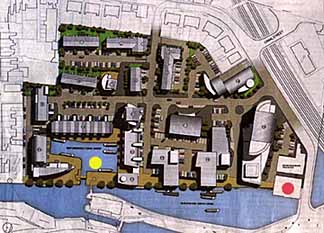 Discussions
about
the
proposals
are
currently
underway
with
the
city
council
and
the
influential
resident's
group,
the Canal
Basin
Community
Forum,
and
these,
it
is
said, may result
in
the
provision
of
25%
of
the
site
being
given
over
to
so-called
"affordable"
housing
although
just
where
these
homes
for
'ordinary'
folk
would
be
located
is
as
yet
uncertain. Discussions
about
the
proposals
are
currently
underway
with
the
city
council
and
the
influential
resident's
group,
the Canal
Basin
Community
Forum,
and
these,
it
is
said, may result
in
the
provision
of
25%
of
the
site
being
given
over
to
so-called
"affordable"
housing
although
just
where
these
homes
for
'ordinary'
folk
would
be
located
is
as
yet
uncertain.
One
thing,
we're
sure
you'll
agree, is clear
from
the
architect's
drawing;
that
the
development
aims
to
pack
in
as
many
profitable
buildings
as
possible
into
the
available
space-
and
that
virtually
not
a
square
foot
of
green
is
anywhere
in
evidence...
But then, almost two years later, in May 2003, the local press reported that the future of the entire affair had been again thrown into question. Prompted by the large number of complaints coming from local residents and groups, city planners have, remarkably, requested that the developers ditch their current proposals and enter into fresh negotiations in order to come up with plans that would be rather more acceptable to the local community, not to mention fellow-objectors English Heritage (presumably because of the rotten architecture), Cheshire County Council Highways (because of transport and access issues)- and the increasingly irrelevant Chester Civic Trust (who actually approved the proposed demolition of the unique Electric Light Building and its replacement by some deeply unpleasant and unsuitable glass-and-steel tower blocks just down the road in the so-called Old Port just a few years back. To everyone's relief but theirs, unsuccessfully as it turned out...)
 This artist's impression of the redeveloped Tower Wharf appeared
during the summer of 2005, when there was a brief flurry of excitement that the project was back on the rails. Telford's Warehouse is on the far right and then it's closely-packed apartment blocks and offices as far as the eye can see... This artist's impression of the redeveloped Tower Wharf appeared
during the summer of 2005, when there was a brief flurry of excitement that the project was back on the rails. Telford's Warehouse is on the far right and then it's closely-packed apartment blocks and offices as far as the eye can see...
This
interesting
reminiscience
about
Tower
Wharf
and
the
old
buried canal
craft
from Alex
Woods appeared
in
the
local
press
in
December
1998:
"When
what
is
seen
as
a
momentous
discovery
falls
within
that
which
you
knew
well
as
a
child,
you
start
to
feel
really
old. In
fact
the
whole
area
from
the
filled-in
basin
along
the
canal
to
the
river
lock
was
a
graveyard
of
boats,
mainly
flats,
which
as
children
we
played
on
and
later
fished
from.
Those
opposite
the
telephone
building
were
in
the
best
condition
and
were
perfectly
safe
to
walk
all
over.
But
at
that
time,
flats,
never
as
wide
as
described
in
some
archival
material,
still
used
to
come
up
the
Dee
on
high
tides,
pass
through
the
swing
bridge
and
eventually
squeeze
through
the
canal
at Northgate
Street.
The
huge
rush
of
water
past
the
boat's
sides
as
the
canal
sought
to
restore
its
level
causing
great
excitement.
It
isn't
really
that
long
ago
though,
is
it?"
 After years of delay, work on the new development at Tower Wharf finally got underway in January 2008. After years of delay, work on the new development at Tower Wharf finally got underway in January 2008.
Users of the towpath running between here and the Millennium Cycleway should note that it has been closed for approximately 20 weeks but that it is still accessible from the far side of the canal via the footbridge.
By October 2008, the sea of mud that for a while comprised the construction site had gone and the new access roads and suchlike were in place but, doubtlessly due to the global banking crisis, all work seemed to have once again ground to a halt. Watch this space for more news and photographs of the changes as they occur. See picture below...
For those readers who would like to know more about Chester's historic canal system, we highly recommend a recently published book edited by local historian and author Gordon Emery (who lives just across the road from Tower Wharf)- The Old Chester Canal: a History and Guide, which is available in local bookshops or send a SAE to 27 Gladstone Road, Chester CH1 4BZ to receive a list of his fascinating and informative books.
The remarkable artist John McGahey drew this fascinating view of the Tower Wharf area as he hung beneath his balloon in 1855...
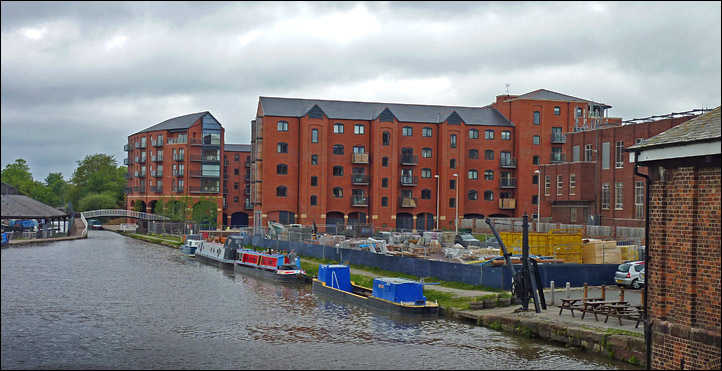
May 2013: new apartment blocks at Tower Wharf

Now, suitably refreshed, we will rejoin the
City Walls and embark on the homeward stretch of our epic journey, via St. Martin's
Gate...
Curiousities from Chester's History no. 25
- 1763
Mr
Evans-Jones
offered
to
pay
the
cost
of
reclaiming
land,
so
that
ships
up
to
100
tons
could
sail
up
to
the
City
Walls,
provided
the
land
so
reclaimed
be
vested
in
him,
on
payment
of
the
usual
Crown
rent.
The
money
was
to
be
accumulated
in
order
to
finance
the
building
of
ships
for
the
benefit
of
the
City
companies,
the
profits
to
be
divided
amongst
them.
Evans-Jones
wished
to
claim
a
levy
on
coals,
lime
and
stone,
and
for
this
reason
the
scheme
was
rejected.
However,
over
1410
acres
of
land
was
reclaimed,
and
a
passage
created
to
the
sea,
by
the
River
Dee
Company.
In
the
same
year,
between
an
application
to
construct
a
cellar
and
a
complaint
about
an
unsafe
well-head,
the
City
Assembly
books
record:
"Upon
reading
the
petition
of
Sheriffs
John
Drake
and
Wm
Dicas
for
£12.16s.
8d
expenses
for
the
execution
of Mary
Heald,
who
was
burned
at Spittle
Boughton on
Saturday
23rd
April
for
the
murder
(by
poisoning)
of
her
husband,
which
exceeded
those
normally
disbursed
by
the
Sheriffs
for
the
common
execution
of
felons
and
malefactors,
the
Treasurer
was
ordered
to
pay
the
same".
"In
reference
to
the
execution
of
Mary
Heald
at
Spittle
Boughton,
in
1763,
I
found
the
article
very
interesting
as
I
had
been
looking
for
quite
awhile
for
some
definite
info
about
her
and
the
execution. For
you
information
she
was
married
in
1749
to
Samuel
Heald,
of
Mere,
and
in
February
1742
had
a
son,
John,
May
1744,
she
had
a
son
Samuel,
Nov
1746,
a
son
Joshua.
Then
in
May
1749
Joshua
died.
In
November
1749,
she
had
a
son,
who
they
named
Joshua.
Then
in
Jan
1752,
Henry
was
born,
Aug
1754
James
born
and
Apr
1757
William
was
born.
Then
tragedy
struck
again
and
Henry
died
in
May
1761,
at
age
8.
Then
in
October
of
the
following
year,
for
reasons
unknown,
Mary
poisons
her
husband
Samuel,
and
passes
into
the
history
book.
My
ancestors
came
from
Mobberley
to
America
in
1703,
Samuel
was
related
to
them
somewhere
along
the
way.
And
I
believe
that
Samuel's
(born
7th
Dec
1709)
parents
were
William
and
Hannah
Heald
of
Nether
Walton. Thank
you
for
the
article,
it
was
very
informative". Bill
Heald,
Sanger,
California 4/12/2000
- 1779 Sarah Jones was executed at Boughton for stealing 28 yards of chintz from the shop of Mr Meacock in Chester.
- 1789 Thomas Mate hung at Boughton for the murder of Constable John Parry at Handbridge. Mate was 64 years old and, when at the gallows, publicly accused his 70 year-old wife of infidelity.
- 1791 Allen, Asten and Knox executed for burglary. Upon this occasion, the fateful tree was removed from Gallows Hill to the other side of the road, whence it remained until 1801 when the place of execution was finally removed within the walls of the city.
|